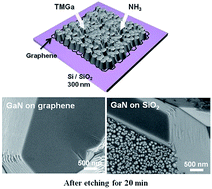Direct growth of etch pit-free GaN crystals on few-layer graphene†
Abstract
We report high-quality GaN crystals grown directly on graphene layers without a buffer layer by metal–organic chemical vapour deposition. Photoluminescence and Raman spectra revealed that GaN crystals grown on graphene layers had mild strain as compared to those grown on sapphire and SiO2 substrates. Etch pits were not observed on the surface of GaN/graphene, in which threading dislocations were diminished inside the bulk. This is markedly different from GaN/sapphire, in which threading dislocations were present on GaN surfaces. This opens a new possibility that graphene with π electrons and hexagonal symmetry could be an ideal substrate for GaN crystal growth instead of expensive sapphire substrates.


 Please wait while we load your content...
Please wait while we load your content...